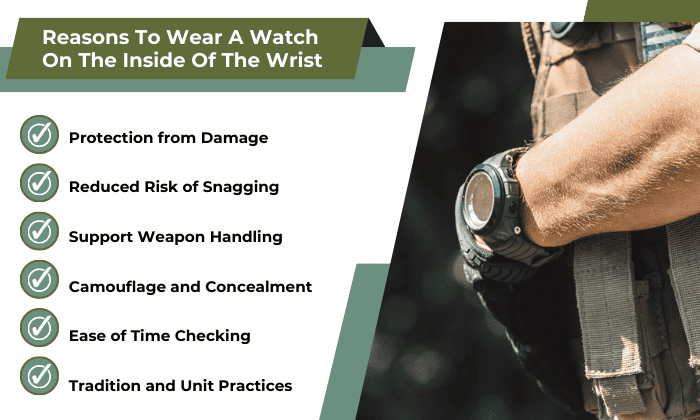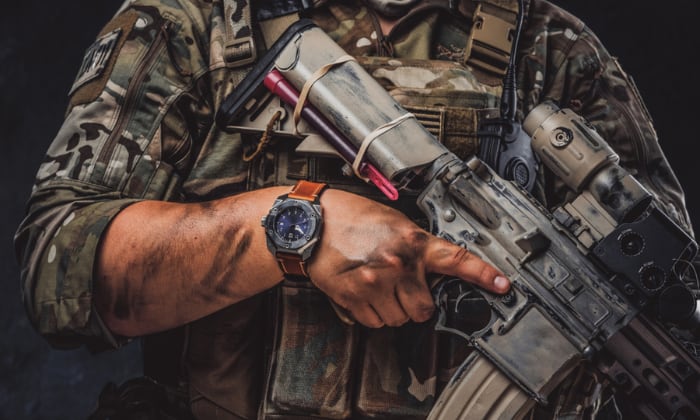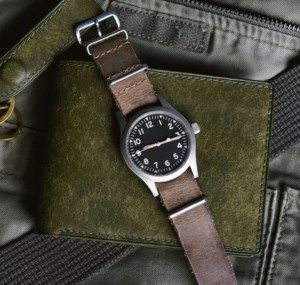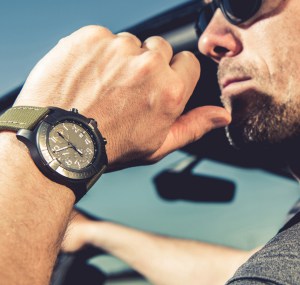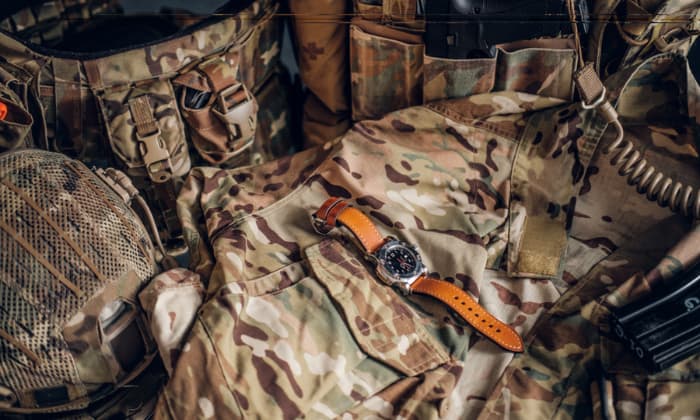Watches have been an integral part of the military culture for centuries, with military personnel wearing them inside their wrist as a tradition. While civilian wearers may be content to wear watches for fashion or convenience, military personnel require their watches to serve a much more critical role.
The practice enables military personnel to keep their watches safe and secure while also allowing them to read the time without obstruction.
In this blog post, we will answer “Why do military wear watches inside wrist?” in more detail and explore the importance of timekeeping in military operations.
Table of Contents
Why Do Military Wear Watches Inside Wrist?
Reasons To Wear A Watch On The Inside Of The Wrist
There are several operational benefits that are especially crucial in military operations for wearing a watch on the inside of the wrist.
- Protection from Damage: By wearing the watch on the inside of the wrist, it’s less exposed, minimizing the risk of damage during maneuver or combat. Besides, the position means the watch’s face is less likely to get scratched or broken, and there is less strain on the watch’s band.
- Reduced Risk of Snagging: Depending on the specific design and environment, wearing a watch on the inside of the wrist may reduce the risk of the watch getting caught on clothing, equipment, or other objects.
- Support Weapon Handling: If a military personnel wears their wristwatch the same as a civilian, chances are that its face will get in the way of their rifle. This can reduce their control of the weapon and aim accuracy, whereas turning the watch outside-in will prevent this from happening.
- Camouflage and Concealment: When turned inside, the watch face will not reflect lights, be it natural or man-made. As such, it prevents distraction for the soldier and keeps them from drawing attention to themselves, which can give away their location.
- Ease of Time Checking: The watch helps soldiers improve their focus and situational awareness, as they do not have to fully rotate their arms to check for the time. They just need to glance down.
- Tradition and Unit Practices: In certain military units or branches, wearing the watch on the inside of the wrist may be a matter of tradition or unit-specific practices. It can serve as a distinguishing factor or a way to foster a sense of camaraderie within the group.
Advantages of Wearing Watches Inside the Wrist
Whether you’re a military personnel from the Marines (or any other branch) or a civilian, here are the benefits of wearing watches inward:
- Eliminate the need for rotating the warm to read the timepiece, thus making reading it discreetly easier
- Prevent the watch from reflecting lights and keep it out of sight
- Keep the timepiece from being damaged, be it from water or external forces
- Make sure the watch doesn’t get in the way
- A cool fashion statement
Psychological & Physiological Factors
There is limited scientific research specifically focused on the psychological and physiological effects of wearing watches on the inside of the wrist, but here are some potential factors to consider.
Psychological factors
- Personal Preference: Wearing a watch on the inside of the wrist may simply be a matter of personal preference or style. Some individuals find it more comfortable or aesthetically pleasing to have the watch face on the inside.
- Individuality and Non-Conformity: Choosing to wear a watch on the inside of the wrist can be a way for individuals to express their individuality or stand out from the norm. Deviating from conventional practices and establishing a unique personality may be a deliberate choice.
Physiological factors
- Increased Flexibility: Wearing a watch on the inside of the wrist may allow for increased flexibility and range of motion in the wrist joint. It could be more comfortable for activities that involve extensive wrist movement, such as sports or manual labor.
- Improve Blood Flow: One disadvantage of wearing the watch the conventional way is that the wristband may press hard against your wrist. This may affect your blood circulation and cause you discomfort.
- Prevent Injury: With its face turned outward, a wristwatch is more likely to catch onto something during physical activities. While unlikely to happen, this can result in injuries.
It is important to note that these factors are largely subjective and vary from person to person. There is no universally applicable set of psychological or physiological effects associated with wearing a watch facing inwards.
Frequently Asked Questions
Is wearing a watch inside the wrist better for accuracy?
There is no scientific support for watches worn inside the wrist providing better accuracy. While military practices advocate for wearing a watch inside the wrist, it is not generally considered to enhance accuracy.
The accuracy of a watch primarily depends on its movement and mechanism, rather than the position on the wrist. If accuracy is a concern, it is advisable to choose a high-quality watch from a reputable brand and ensure regular maintenance and calibration.
Note: However, it is believed that if you wear Apple watch on the inside of the wrist, you can enjoy better accuracy from sensors.
Do military watches have special features compared to civilian watches?
Yes, military watches often have special features and design characteristics that distinguish them from civilian watches. These features are typically tailored to meet the specific needs and requirements of military personnel in the field, such as:
- Durability and protection against harsh weather conditions
- Night vision compatibility and night-vision goggles.
- Enhanced water resistance to ensure they can withstand water exposure during aquatic operations, swimming, or diving.
- Compass and navigation functions to aid in land navigation and orientation during missions.
- Chronograph functions for precise timing of events, missions, or exercises.
- Anti-magnetic properties to prevent magnetic fields from interfering with the watch’s accuracy, particularly in environments with electronic equipment or explosives.
But note that not all military watches will have all these features, as the requirements can vary based on the intended use and the branch of the military.
What arm do men wear watches?
Traditionally, men wear watches on their non-dominant hand, which is typically the left hand. The reason for this convention is practicality and convenience. By wearing the watch on the non-dominant hand, it is less likely to interfere with activities that require dexterity or fine motor skills, such as writing, using tools, or operating equipment.
However, personal preferences can vary, and there is no hard and fast rule dictating which wrist men should wear their watches on. Some men may prefer wearing watch on right hand if they are left-handed or simply because they find it more comfortable or aesthetically pleasing.
Does the military wear watches backwards or wear watches upside down?
Yes, some military personnel wear their watches in what is commonly referred to as a “backward” or “upside down” orientation. Instead of wearing the watch with the dial facing up and the crown on the right side, they wear it with the dial facing inward and the crown on the left side of the wrist.
This positioning may create the appearance that the watch is worn “backward” or “upside down” when compared to the standard way of wearing a watch.
Conclusion
In conclusion, the answer to, “Why do military wear watches inside wrist?” can be attributed to a range of tactical and practical reasons.
The camouflage and concealment benefits of minimizing glint and reflection, along with increased protection against accidental damage, make the inside wrist position appealing. Additionally, the convenience of discrete time checking and improved comfort during physically demanding activities contribute to the practice.
Whether it is for tactical advantages, unit traditions, or personal preferences, the decision to wear watches on the inside of the wrist in military settings reflects the unique needs and circumstances of those serving in such roles.

I am Everett Bledsoe, taking on the responsibility of content producer for The Soldiers Project. My purpose in this project is to give honest reviews on the gear utilized and tested over time. Of course, you cannot go wrong when checking out our package of information and guide, too, as they come from reliable sources and years of experience.


